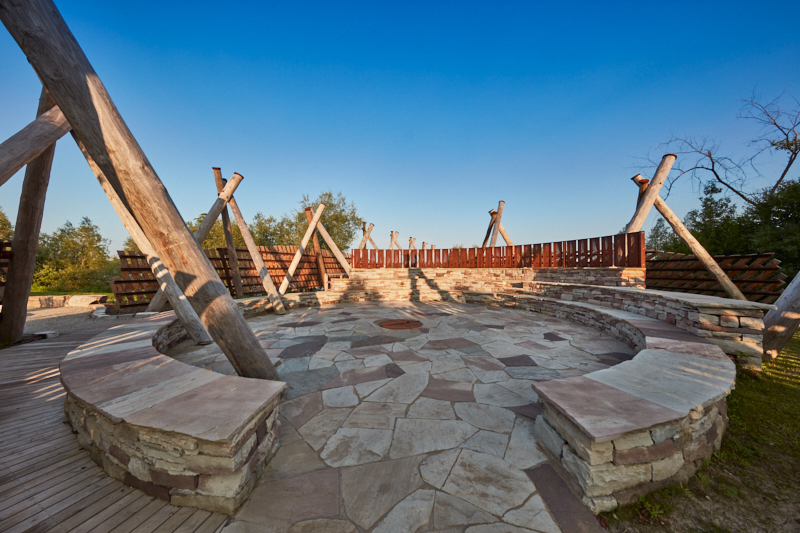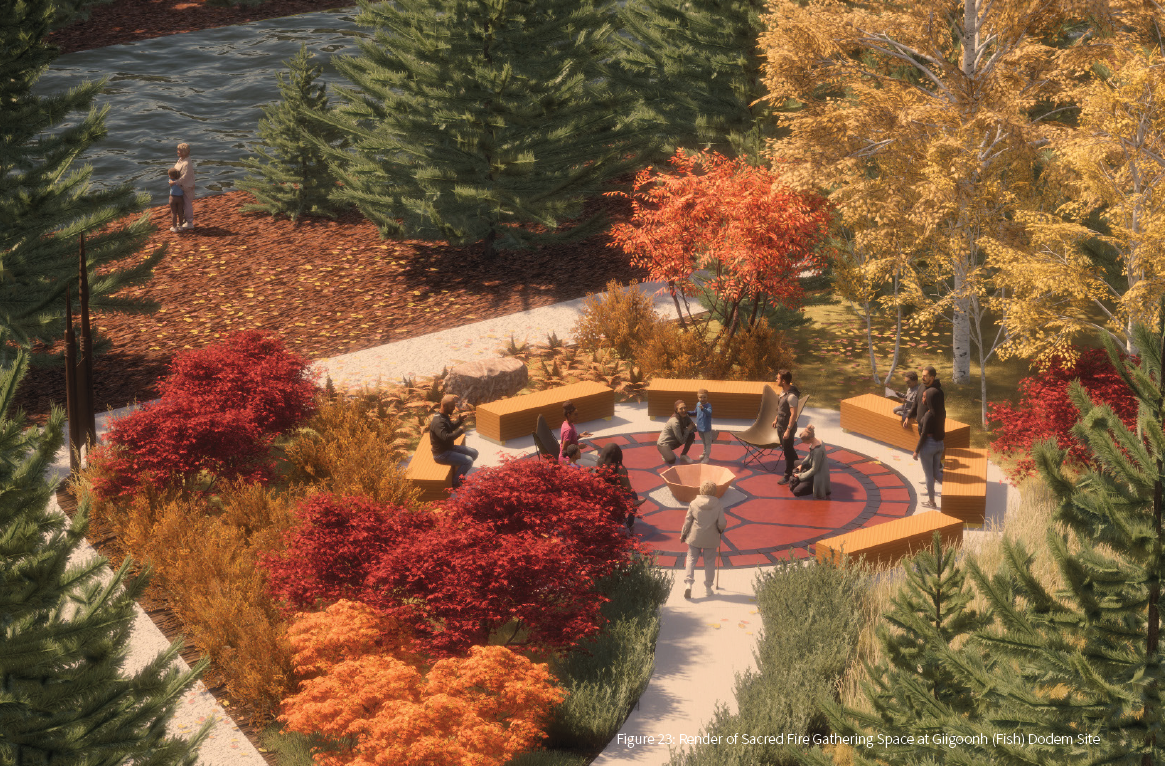Indigenous Placemaking Along the Credit Valley Trail
Spanning more than 100 kilometres from the headwaters in Orangeville and Mono to the shores of Lake Ontario, the Credit Valley Trail (CVT) winds through the Treaty Lands and Territory of the Mississaugas of the Credit First Nation (MCFN), as well as the traditional territories of the Huron-Wendat and Haudenosaunee peoples.
More than just a scenic route, the CVT is intended to be a living expression of Indigenous presence—honouring the histories, cultures and enduring relationships that continue to shape the Credit River and its surrounding valley lands.
Accompanying the collective goal to connect the route, Credit Valley Conservation (CVC) and CVT partners are committed to developing dedicated space along the trail to recognize and honour Indigenous knowledge, history and present-day culture. The CVT Indigenous Roundtable (IRT), an Indigenous led committee made-up of community representation from the MCFN, Cree and Huron-Wendat First Nations, is guiding the planning process to achieve this goal.
In collaboration with CVC and CVT partners, the IRT finalized the Indigenous Experience Plan (IEP) in 2019, accelerating their vision to bring Indigenous culture and experiences to life along the trail. The plan provides a set of recommendations to showcase Indigenous culture through trail markers, public art installations and gathering spaces. You can learn more about the Indigenous Experience Plan.
How You Can Support Indigenous Placemaking Along the CVT
- Make an online donation today.
- Make a donation via mail or phone. You can download our printable CVCF donation form and return with your cheque or money order, or call 905-670-1615 to make a donation by credit card.
- Get your business or community organization involved.
You have the opportunity to make a direct and meaningful impact in our community. Whether through sponsorships, donations, in-kind services, or volunteers, there are countless ways we can collaborate to support Indigenous placemaking along the CVT. To explore how you can get involved, please contact: Dayana Gomez, Executive Director, Credit Valley Conservation Foundation
Creating the CVT Indigenous Experience Plan
At the heart of the CVT’s vision is the integration of Indigenous perspectives, knowledge and cultural expressions. In 2017, Credit Valley Conservation (CVC) partnered with the Mississaugas of the Credit First Nation (MCFN) and other Indigenous community members to establish the CVT Indigenous Roundtable (IRT)—an Indigenous-led advisory group composed of representatives from MCFN, Cree, Huron-Wendat, and other First Nations.
In 2019, the IRT, in partnership with CVC, finalized the Indigenous Experience Plan (IEP). This plan outlines a vision for the creation of seven key sites along the CVT, each representing an Anishinaabe doodem (clan) and serving as a focal point for storytelling, teachings and cultural engagement. These sites will feature interpretive signage, public art installations and gathering spaces designed to foster understanding and appreciation of Indigenous heritage and culture.
The first key site— Ajijaak Doodem, The Crane Gathering Space—is now complete, and design is underway for the second site: Giigoonh Doodem – The Fish Site. Planning for the remaining five sites will continue over the coming years as part of this shared and evolving vision.

CVT Indigenous Experience Plan Overview– Concept Map for Seven Key Sites
Following the Indigenous Experience Plan, the IRT have identified seven key sites to be constructed along the CVT route. Each site will be represented by an Anishinaabe dodem (clan system) and incorporates an Indigenous experience narrative that includes storytelling, teachings, symbology and other cultural elements.
CVC and the IRT are currently developing Key site #1 and #2.
Interpretive Signage at the Crane Gathering Space
Credit Valley Conservation has installed interpretive signage at the Crane Gathering Space at Island Lake Conservation Area. This project received Government of Canada support through the Federal Development Agency for Southern Ontario (FedDev Ontario).
Placemaking Priorities
Ajijaak Doodem – The Crane Gathering Space
Located at CVC’s Island Lake Conservation Area and marking the northern trailhead of the Credit Valley Trail, the Crane Gathering Space is the first of the seven Indigenous Experience Plan sites.
Inspired by the Ajijaak (Crane) Doodem—a symbol of leadership and communication in Anishinaabe culture—this space reflects the Crane’s role as the clan’s speaker: a powerful messenger that brings clarity, announces change, and leads with wisdom.
The architectural design draws on the symbolism of the Crane and incorporates elements of traditional fishing practices. This symbolism is echoed in the natural migration of the Sandhill Crane, which stops at Island Lake each year, linking the site to the land’s seasonal rhythms.
Built in 2024, the Crane Gathering Space now serves as a venue for ceremonies, teachings, and community events that honour Indigenous presence and tradition.
Inquire about booking or learn more about the space.

Photo credit: Smoke Architecture and Francis Fougere

![]()
Giigoonh Doodem – The Fish Site
The second key site, representing the Giigoonh (Fish) Doodem, is currently being developed at CVC’s future Charles Sauriol Conservation Area.
In collaboration with the Indigenous Roundtable, CVC is shaping a concept that weaves together the Grandfather Teachings with ecological stewardship—highlighting the importance of protecting brook trout habitats and acknowledging the historic presence of salmon in the area.
Watch the video, where Elder Garry Sault of the Mississaugas of the Credit First Nation shares the Grandfather Teachings and their connection to “the laws of the fish.” Elder Garry is Chair of the Indigenous Roundtable and a respected Elder of MCFN.
Stay tuned for updates as the site design continues to evolve.

Conceptual renderings for the future Giigoonh Doodem, Fish site.
Support the CVT’s Indigenous Vision
As the CVT continues to grow, each of the remaining five key sites will be thoughtfully developed to reflect the diverse cultural narratives and spiritual connections of Indigenous communities. Through these efforts, the CVT aims to honour the past, celebrate the present, and build a shared future grounded in respect, understanding, and collaboration. You can help support the development of these important cultural spaces—donate today.
Interested in getting involved with the Credit Valley Trail or support these transformative initiatives?
Please contact Natalie Faught, Credit Valley Trail Coordinator.
